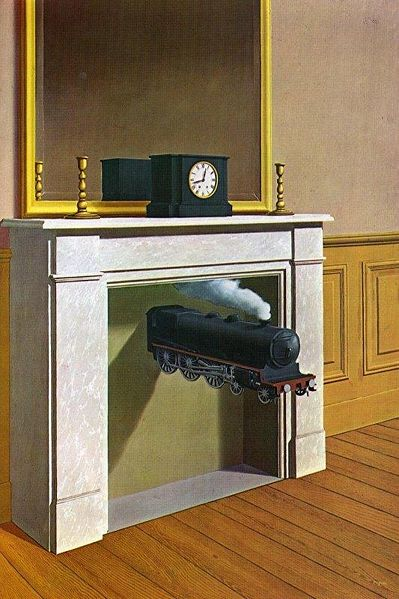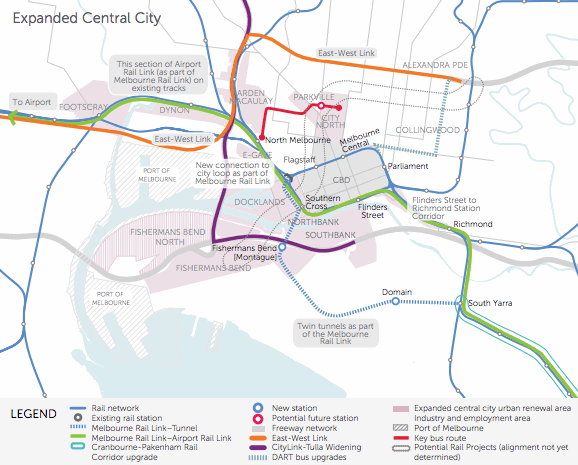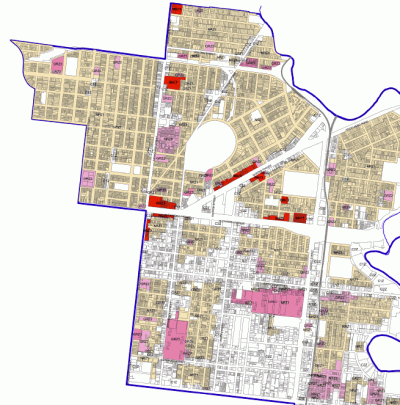home » news » urban planning » Australia » Victoria
Railroaded
 In May’s Victorian state budget, the Metro Rail Capacity Project was officially abandoned and relaunched as the smaller, Southern-focused Melbourne Rail Link. It’s been under consideration for less than three months, and looks to have been rushed out in time for the November state election. They’ve earmarked $8.6B – $11B, which includes (a bit like steak knives) a distant airport rail link branching off the Sunbury line.
In May’s Victorian state budget, the Metro Rail Capacity Project was officially abandoned and relaunched as the smaller, Southern-focused Melbourne Rail Link. It’s been under consideration for less than three months, and looks to have been rushed out in time for the November state election. They’ve earmarked $8.6B – $11B, which includes (a bit like steak knives) a distant airport rail link branching off the Sunbury line.
There’s no start date for any of this, but the changes put back “threshold” readiness of Metro Rail by at least four years. Treasurer O’Brien says the shovels are ready, but if they bought shovels, they won’t be able to use them for a while yet. The Metro project was due to start in January 2015 ( Infrastructure Australia submission ), so now nothing will happen for the forseeable if the Liberals return to power in November. According to the new Plan Melbourne, the Link will become “progressively operational” between 2017 and 2021. It’s quite a clever ploy, appearing to be pushing forward with rail but effectively stalling it. I might be less cynical about it had the government raised its fundamental objections to the scheme before spending millions developing it to the point that it is ready to be built.
One factor that held some sway on Spring Street was the federal government’s putting the kibosh on public transport. The Coalition made it clear well before they were elected that they were not interested in funding rail, and 36 hours before the election confirmed the diversion of the initial Metro Rail funding of $150M into a $19B splurge on road projects.
The new route does build some inner rail capacity, but the extent cannot be confirmed – the figures are all preliminary and a $547K business case will not be released publicly. Ernst and Young will have spent three months working on it. Evans and Peck have been working for years on the Metro Rail business cases.
We have been told that the capacity of the City Loop will increase more with Rail Link than it would have with its predecessor. We just have to believe them on that front, as the details aren’t available. Transport blogger Daniel Bowen looked under some stones and decided that the new capacity figures are probably based on the use of high capacity trains – the problem being that only 25 are to be ordered…
Avoiding patrons in significant services and population centres in Melbourne’s inner North, the project favours the site of the government’s “CBD 2” development at Port Melbourne. A Fisherman’s Bend extension was always in the plans, but was low priority – to happen in 15 to 20 years when the Bend has gained a population. The reprioritisation was apparently at the behest of the Premier’s office, and has had little if any planning input – well not planning as we used to know it. Minister for Planning Matthew Guy sees the Rail Link as a boon for his new development:
“The largest urban renewal project in Australia must have a railway station.”
Guy further justifies the Link by saying that it will provide 3,700 jobs. That’s planning these days.
It’s great that a new urban development is promised a railway line when it’s barely out of the ground. That’s forward thinking. It’s like the private railways built to new suburbs in the Nineteenth Century (one of which went right through this area until 1987). The new line increases Fisherman’s Bend’s attractiveness in the eyes of developers and investors, even if at some cost. Too bad about the busy institutions that were to share the Parkville railway station in the Metro Rail scheme. These included the Royal Melbourne Hospital, the new Children’s Hospital, the Women’s Hospital, the new Cancer centre, and the Univeristy of Melbourne. These will be serviced by a “key bus route” to North Melbourne…

Moving Victoria graphic, 2014
As with the East-West Link, the government has found a way to steer infrastructure dollars into serving marginal electorates and more safely-held South Eastern seats. This time the realignment favours the South, particularly the marginal Albert Park seat. Spring Street rumour has it that the resident Labour MP is preparing to pack his bags.
Rail Link steers clear of servicing Melbourne’s Inner North and West, where the Liberal Party doesn’t have a chance at the election. But Melbourne also happens to be the fastest growing statistical division in the nation. In addition to being the commercial and retail hub, the population jumped 10.5% in 2012-13, 23% if you focus on the CBD alone. Instead of servicing the increasingly dense inner North with several train stations, Rail Link will service an off ramp at the Westgate Freeway with one station.
It was obvious that Premier Napthine was no fan of the Metro Rail project. He was in 2012 but changed his mind this February. His surprise attitude shift is purportedly to do with disruption to Swanston Street – Napthine wants to save it from turning it into a “Berlin Wall” during construction. The reasoning should also apply to East West Link, which will disrupt Alexandra Parade for years with tunnelling, but this appears to be a more palatable sacrifice for the premier.
It’s debatable whether Swanston Street would have become a “Berlin Wall”. Another independent blogger has researched this furphy, coming to the conclusion that cut-and-cover construction of Metro Rail would have been impossible due to Swanston Street’s gradient and the depth that is needed in order to pass beneath the Yarra River. Geological surveys show the trains at least 30 metres beneath the city, requiring tunnel boring. This blogger also makes the point that where Metro Rail passed through solid ground, Rail Link has a much trickier route through the sandy soils that prevail along its whole length. There’s also the slight problem of Melbourne’s main sewer pipe, which is in the path of the line.
So the reasons we’ve been given for the new route are that it passes through a new speculative development project, that it has a higher capacity, that’s it’s a cheaper “two-for-one” deal, and that it won’t cause disruption to Swanston Street. This is blind to the bigger picture, but soon reports will be written that reinforce the government’s opinion. That’s what commissioned reports are for these days (sorry, I have become a little jaded in recent times).
“the Melbourne Rail Link will act as a major catalyst to ignite commercial development in the [Fisherman’s Bend] area.” Moving Victoria: Why Melbourne Rail Link?
The 2008 Eddington study did look at the bigger picture. It seems from this report that it’s a pretty simple equation. To increase the capacity of the rail network and to provide a better service to the outer growth areas, the City Loop needs to have the pressure taken off it. This is what Metro Rail did, by by-passing it. Eddington didn’t think a railway to Doncaster was viable, preferring “smart” buses. But if the time came for it, Doncaster and South Morang lines could have hooked into the North end of Metro Rail. This would remake the lost Northern cross connection, taking a bundle of commuters out of the city. Metro Rail also took the pressure off the three lines Northern and Western lines converging on North Melbourne Station, by taking the Western line on a separate route. Metro Rail wasn’t perfect, but it looked beyond itself in ways that the Rail Link fails to take into account.

Ashworth Report, 1940
The path of Metro Rail pops up (approximately) in a report that predates the Eddington report by at least 70 years. Victorian Railways’ Ashworth Report of 1940 shows a line running due North from the CBD and connecting into the now decommissioned line that we know as Linear Park in Princes Hill. The purpose of the Ashworth Report was to set out a decades-long plan of action to better support out-lying suburbs.
The Ashworth Report did include rail to Doncaster, as an extension to the Kew line. But the Kew line was closed in 1952. The VicRoads Headquarters opened on the site of the demolished Kew Railway Station. Fitting, that.
Dr Mees checks the figures
Was Eddington’s Metro Rail all it was cracked up to be? In 2010 the late Paul Mees investigated in great detail the sudden and unexpected appearance of Metro Rail and the Regional Rail Link ( here’s the PDF ). He found it curious that Labour had put them on the table having omitted them from its major “Melbourne 2030” plan of 2002, 2004’s “Linking Melbourne: Metropolitan Transport Plan” and 2006’s “Meeting Our Transport Challenges: Connecting Victorian Communities”. These plans focused on a third track on the Dandenong line. It wasn’t until 2008 that Metro Rail surfaced in Rod Eddington’s road-focused East-West link needs assessment report. Mees found that the Eddington team contained no people with experience in public transport planning, and had based its optimistic rail patronage forecasts on linear extrapolations of old figures – extrapolations that were way off the mark by 2010 when Mees published his study.
Eddington’s report was quickly followed by the last of the biannual transport plans, the Victorian Transport Plan. This promoted the Regional rail Link and Metro Rail project (in a revised form) and dumped the Dandenong line improvements without explanation (as of May 2014 this project is back in a different form).
Mee’s argument against the assumptions behind Metro Rail stems from an earlier paper of his which suggested that the rail network in 2007 was running well below capacity. He noted that Flinders Street station has never been busier than it was in 1929, and that patronage of the system peaked in the 1950s. The official response to Mees came from the Department of Transport, standing up for their Dandenong rail upgrade plans. They said that express trains compromised the system and meant that fewer trains could run than in the past. In 2010, with the once vital Dandenong line work dead in the water, Mees could find no evidence that stacked up for the Metro Rail project. The Eddington team seemed to be borrowing the dud figures justifying the dumped Dandenong improvements for a new project somewhere else.
Those interested should really read the Mees report, as it contains far more relevant and revelatory information than I can nutshell here. Mees’ explosive report suggests that neither of Eddington’s road or rail proposals have been adequately vetted, and that the Benefit Cost Ratios (BCRs) being quoted today are a great deal higher than those calculated in 2008, even though the costs have increased substantially. The “wider economic benefits” forecasts used to inflate these numbers are borrowed from rather fuzzy UK research that is perhaps best left in the UK.
The state government was not too interested in Metro Rail in 2013, looking the gift horse of $3B federal funding in the mouth. State treasurer Michael O’Brien thought there wouldn’t be enough workers for it due to East-West Link construction. Then the federal government changed, the funding evaporated, and they stopped talking about rail.
A possible reason for the government to suddenly regain a keenness for rail is political. In early March, a poll was published finding that only one in four voters thought that The East-West Link was a high priority project. Metro Rail received twice that support. Labour has guaranteed Metro Rail will happen with them. Throw in a train to the airport, and at first glance the incumbents are ahead of Labour in their commitment to rail.
In May I watched as the PTV website steadily removed its Metro Rail content – it seemed to have been caught out by the announcement as their Metro Rail page was still available a week after the Rail Link announcement – it now redirects to the Department of Transport’s Rail Link page, suggesting to me that the PTV had little, if anything to do with the switch. While it’s still available, check out the PTV’s Metro Rail video here . You might then compare it with the government’s new video for the Rail Link. Both are well-spun. The figures stated appear to be based on a trail of assumptions that gets cloudy rather quickly.
Having poked around for the last month or so and found more questions than answers, I reckon that the MRL is an expedient and fairly useless approximation of the Metro Rail project. Metro Rail was a project which was fast-tracked from pre-feasibility to contract documentation without the proper steps in-between. Why? Maybe it’s easier and looks better to invest billions in infrastructure and jobs than to ask Public Transport Victoria to improve its timetabling. Maybe it looks better to concentrate money on big-ticket projects in the central city than spread it quietly through the expanding suburbs where roads rule and rail fails.
“The real problem with the Melbourne rail system is what the international expert Professor Vukan Vuchic calls ‘self-defence of incompetence’, as the Department of Transport and Connex collaborate to shield each other from suggestions that efficiency can be improved. Rather than fixing this problem, Eddington proposes to reward the incompetence with $8.5 billion in capital funding.” Paul Mees, 2008
Dr Mees, I think we need you back.
Links
- DoT Melbourne Rail Link
- Crikey – Alan Davies
- PTV Metro Rail Capacity Project – archived version due to recent page deletion.
- Paul Mees 2010: Planning for major rail projects: The Melbourne Metro and Regional Rail Link
- Paul Mees, 2008 Does Melbourne Need another Central City Rail Tunnel?
top image: Magritte’s time transfixed, 1938
Posted by Peter on 20.06.14 in urban planning
comment
Its hard isn’t it to assess these things when so few details are provided, like whether swanston st would have to be dug up or not. Or of course any political reasons. Four instance, not sure if the MRL was decided on because it advantages liberal voting areas instead of labour ones – surelky they would concentrate on marginals ? If it increases service on frankston line that would make sense, but as you say easier ways to do that, not mention actually building the Southland station. Anyhoo, I rekon they’ve chosen this one because a. its cheaper (probably, and as you say pputs off spending anything anytime soon), b. encourages development at fish bend (though only one end really) but mainly c. there’s an airport rail line connected to the southeast – I think they think that’s a vote winner generally (though it doesn’t seem to have generated much positive noise, and oddly at the same time the EWL and tulla widening would make driving easier). And as you say, nothing will happen for years….
by rohan on 06/08/14 ·#
Commenting is closed for this article.


